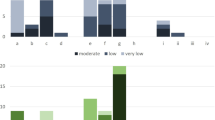Abstract
We pilot tested the Status Update Project (SUP) mobile app intervention to promote repeat HIV testing among HIV-negative US MSM. Participants (Mean age = 29 years; 51% racial/ethnic minority; 63% single) who were eligible and enrolled were randomized to either the SUP mobile app or a no-treatment condition, with assessments at baseline and month 4 and 8. Eighty-three percent of men were retained at the 8-month follow up. Among men randomized to the SUP arm, the app’s ease and simplicity, health information, HIV testing locator, and HIV test reminders were most liked. At month 4, men randomized to the SUP arm were more likely to be repeat testers compared to those in the control arm (RR = 4.4; 95% CI 0.9, 19.9), although differences diminished by month 8 (RR = 1.2; 95% CI 0.8, 2.0). These findings add to our understanding of how mHealth interventions may play an important role in encouraging repeat HIV testing among MSM.








Similar content being viewed by others
References
Centers for Disease Control and Prevention. HIV Surveillance Report, 2017; vol. 29. https://www.cdc.gov/hiv/pdf/library/reports/surveillance/cdc-hiv-surveillance-report-2017-vol-29.pdf (2018). Accessed 20 Dec 2018.
Centers for Disease Control and Prevention. HIV Care Saves Lives: Vital Suppression is Key. https://www.cdc.gov/vitalsigns/hiv-aids-medical-care/index.html (2014). Accessed 5 June 2019.
Branson B, Handsfield H, Lampe M, et al. Revised recommendations for HIV testing of adults, adolescents, and pregnant women in health-care settings. MMWR Recomm Rep. 2006;55(RR-14):1–17 quiz CE11-14.
DiNenno EA, Prejean J, Irwin K, et al. Recommendations for HIV screening of gay, bisexual, and other men who have sex with men - United States, 2017. MMWR. 2017;66(31):830–2.
An Q, Song R, Finlayson TJ, Wejnert C, Paz-Bailey G. Estimated HIV inter-test interval among people at high risk for HIV infection in the U.S. Am J Prev Med. 2017;53(3):355–62.
Marano M, Stein R, Song W, et al. HIV testing, linkage to HIV medical care, and interviews for partner services among black men who have sex with men—non-health care facilities, 20 Southern U.S. Jurisdictions, 2016. MMWR. 2018;67(28):778–81.
Marks G, Crepaz N, Senterfitt JW, Janssen RS. Meta-analysis of high-risk sexual behavior in persons aware and unaware they are infected with HIV in the United States: implications for HIV prevention programs. J Acquir Immune Defic Syndr. 2005;39(4):446–53.
Whitham HK, Sansom SL, Wejnert C, et al. Sex practices by HIV awareness and engagement in the continuum of care among MSM: a national HIV behavioral surveillance analysis in 21 U.S. cities. AIDS Behav. 2018;22(3):840–7.
Centers for Disease Control and Prevention. HIV infection risk, prevention, and testing behaviors among men who have sex with men - National HIV Behavioral Surveillance, 23 U.S. Cities, 2017. https://www.google.com/search?client=firefox-b-1-d&q=Centers+for+Disease+Control+and+Prevention.+HIV+infection+risk%2C+prevention%2C+and+testing+behaviors+among+men+who+have+sex+with+men+-+national+HIV+behavioral+surveillance%2C+23+cities%2C+2017 (2019). Accessed 2 July 2019.
Mitchell J, Horvath KJ. Factors associated with regular HIV testing among a sample of US MSM with HIV-negative main partners. J Acquir Immune Defic Syndr. 2013;64:417–23.
Biello KB, Marrow E, Mimiaga MJ, Sullivan P, Hightow-Weidman L, Mayer KH. A mobile-based app (MyChoices) to increase uptake of HIV testing and pre-exposure prophylaxis by young men who have sex with men: protocol for a pilot randomized controlled trial. JMIR Res Protoc. 2019;8(1):e10694.
Liu A, Coleman K, Bojan K, et al. Developing a mobile app (LYNX) to support linkage to HIV/sexually transmitted infection testing and pre-exposure prophylaxis for young men who have sex with men: protocol for a randomized controlled trial. JMIR Res Protoc. 2019;8(1):e10659.
Gamarel KE, Darbes LA, Hightow-Weidman L, Sullivan P, Stephenson R. The development and testing of a relationship skills intervention to improve HIV prevention uptake among young gay, bisexual, and other men who have sex with men and their primary partners (We Prevent): protocol for a randomized controlled Trial. JMIR Res Protoc. 2019;8(1):e10370.
Bauermeister JA, Golinkoff JM, Horvath KJ, Hightow-Weidman LB, Sullivan PS, Stephenson R. A multilevel tailored web app-based intervention for linking young men who have sex with men to quality care (Get Connected): protocol for a randomized controlled trial. JMIR Res Protoc. 2018;7(8):e10444.
Simoni JM, Kutner BA, Horvath KJ. Opportunities and challenges of digital technology for HIV treatment and prevention. Curr HIV/AIDS Rep. 2015;12(4):437–40.
LeGrand S, Muessig KE, Horvath KJ, Rosengren AL, Hightow-Weidman LB. Using technology to support HIV self-testing among MSM. Curr HIV/AIDS Rep. 2017;12(5):425–31.
McCoy SI, Buzdugan R, Grimball R, et al. Stick To It: pilot study results of an intervention using gamification to increase HIV screening among young men who have sex with men in California. mHealth. 2018;4:40.
Bauermeister JA, Pingel ES, Jadwin-Cakmak L, et al. Acceptability and preliminary efficcy of a tailored online HIV/STI testing intervention for young men who have sex with men: the Get Connected! Program. AIDS Behav. 2015;19(10):1860–74.
Bauermeister JA, Tingler RC, Demers M, et al. Acceptability and preliminary efficacy of an online HIV prevention intervention for single young men who have sex with men seeking partners online: the myDEx project. AIDS Behav. 2019;23:3064–77.
Mitchell JW, Lammert S, Danh T, Horvath KJ. Optimizing enrollment methods: lessons learned from an mHealth, pilot HIV prevention randomized controlled trial with sexual minority men. Int J STD AIDS. 2019;30(7):703–6.
Mitchell JW, Torres MB, Asmar L, Danh T, Horvath K. Developing sustainable and impactful mobile phone HIV testing interventions for Spanish-speaking men who have sex with men in the United States (US): lessons learned from informative interviews. JMIR Public Health Surveill. 2018;4(2):e45.
Mitchell JW, Torres MB, Joe J, Danh T, Gass B, Horvath KJ. Formative work to develop a tailored HIV testing smartphone application for diverse at-risk HIV-negative men who have sex with men: a focus group study. J Med Internet Res uHealth Health. 2016;4(4):e128.
Zhang W, O’Brien N, Forrest JI, et al. Validating a shortened depression scale (10 item CES-D) among HIV-positive people in British Columbia, Canada. PLoS ONE. 2012;7(7):e40793.
Saunders JB, Aasland OG, Babor TF, de la Fuente JR, Grant M. Development of the alcohol use disorders identification test (AUDIT): WHO Collaborative Project on Early Detection of Persons with Harmful Alcohol Consumption-II. Addiction. 1993;88(6):791–804.
Horvath KJ, Oakes JM, Rosser BRS, Danilenko G, Vezina H, Amico KR, Williams ML, Simoni J. Feasibility, acceptability and preliminary efficacy of an online peer-to-peer social support ART adherence intervention. AIDS Behav. 2013;17(6):2031–44.
Carey MP, Schroder KE. Development and psychometric evaluation of the brief HIV knowledge questionnaire. AIDS Educ Prev. 2002;14(2):172–82.
Napper LE, Fisher DG, Reynolds GL. Development of the perceived risk of HIV scale. AIDS Behav. 2012;16(4):1075–83.
Brooke J. A quick and dirty usability scale. In: Jordan PW, Thomas B, Weerdmeester BA, McClellend I, editors. Usability evaluation in industry. London: Taylor and Francis; 1996.
Sullivan PS, Driggers R, Stekler JD, et al. Usability and acceptability of a mobile comprehensive HIV prevention app for men who have sex with men: a pilot study. JMIR Mhealth Uhealth. 2017;5(3):e26.
Almirall D, Nahum-Shani I, Sherwood NE, Murphy SA. Introduction to SMART designs for the development of adaptive interventions: with application to weight loss research. Transl Behav Med. 2014;4(3):260–74.
Acknowledgements
We would like to thank participants for the time they offered during the conduct of this study. Research reported in this publication was supported by the National Institute of Mental Health of the National Institutes of Health under award number R34-MH-105202. The content is solely the responsibility of the authors and does not necessarily represent the official views of the National Institutes of Health.
Author information
Authors and Affiliations
Corresponding author
Additional information
Publisher's Note
Springer Nature remains neutral with regard to jurisdictional claims in published maps and institutional affiliations.
Rights and permissions
About this article
Cite this article
Horvath, K.J., Lammert, S., Danh, T. et al. The Feasibility, Acceptability and Preliminary Impact of Mobile Application to Increase Repeat HIV Testing Among Sexual Minority Men. AIDS Behav 24, 1835–1850 (2020). https://doi.org/10.1007/s10461-019-02755-7
Published:
Issue Date:
DOI: https://doi.org/10.1007/s10461-019-02755-7




